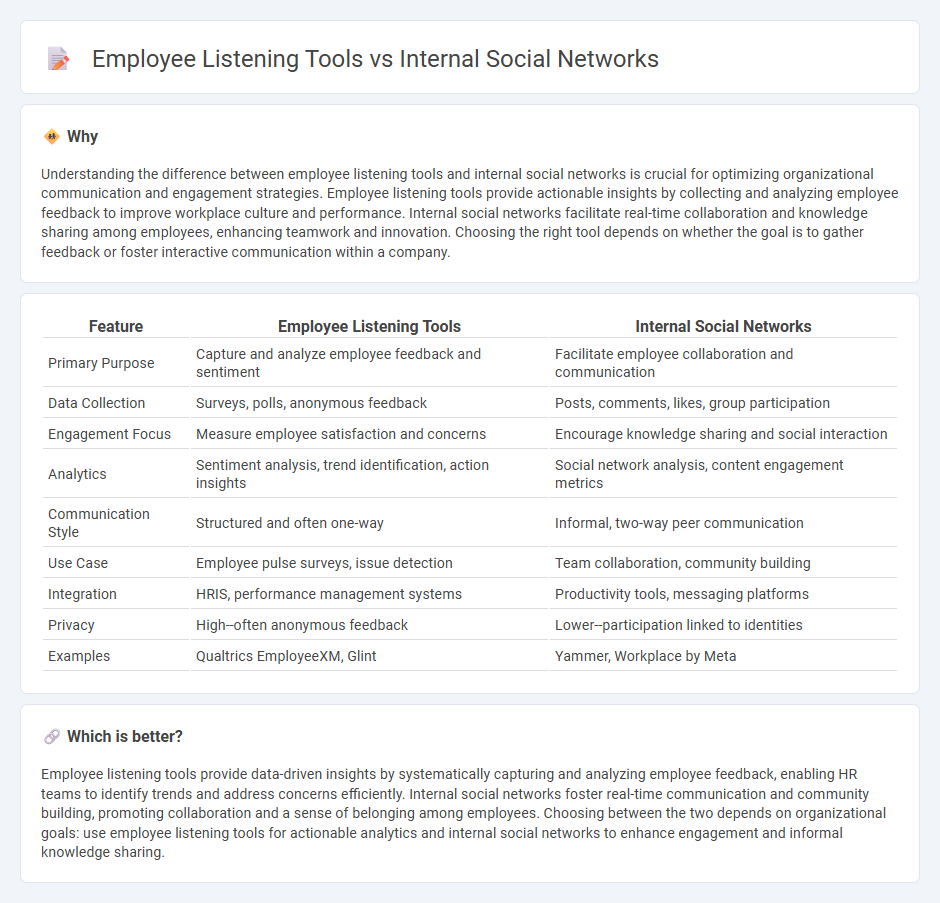
Employee listening tools capture real-time feedback and sentiment analysis to improve workplace engagement and address concerns quickly. Internal social networks foster collaboration and communication among employees, enhancing knowledge sharing and team cohesion. Explore the differences and benefits of both to optimize your organization's HR strategy.
Why it is important
Understanding the difference between employee listening tools and internal social networks is crucial for optimizing organizational communication and engagement strategies. Employee listening tools provide actionable insights by collecting and analyzing employee feedback to improve workplace culture and performance. Internal social networks facilitate real-time collaboration and knowledge sharing among employees, enhancing teamwork and innovation. Choosing the right tool depends on whether the goal is to gather feedback or foster interactive communication within a company.
Comparison Table
| Feature | Employee Listening Tools | Internal Social Networks |
|---|---|---|
| Primary Purpose | Capture and analyze employee feedback and sentiment | Facilitate employee collaboration and communication |
| Data Collection | Surveys, polls, anonymous feedback | Posts, comments, likes, group participation |
| Engagement Focus | Measure employee satisfaction and concerns | Encourage knowledge sharing and social interaction |
| Analytics | Sentiment analysis, trend identification, action insights | Social network analysis, content engagement metrics |
| Communication Style | Structured and often one-way | Informal, two-way peer communication |
| Use Case | Employee pulse surveys, issue detection | Team collaboration, community building |
| Integration | HRIS, performance management systems | Productivity tools, messaging platforms |
| Privacy | High--often anonymous feedback | Lower--participation linked to identities |
| Examples | Qualtrics EmployeeXM, Glint | Yammer, Workplace by Meta |
Which is better?
Employee listening tools provide data-driven insights by systematically capturing and analyzing employee feedback, enabling HR teams to identify trends and address concerns efficiently. Internal social networks foster real-time communication and community building, promoting collaboration and a sense of belonging among employees. Choosing between the two depends on organizational goals: use employee listening tools for actionable analytics and internal social networks to enhance engagement and informal knowledge sharing.
Connection
Employee listening tools and internal social networks are interconnected platforms that enhance organizational communication and employee engagement. Employee listening tools gather real-time feedback and sentiments, enabling HR to identify workplace issues and measure employee satisfaction effectively. Internal social networks facilitate open dialogue and collaboration, amplifying insights gained from listening tools and fostering a culture of transparency and inclusiveness.
Key Terms
Collaboration
Internal social networks enhance collaboration by enabling real-time communication, knowledge sharing, and team engagement across departments. Employee listening tools facilitate collaboration by capturing feedback, monitoring sentiment, and measuring employee experience to inform management decisions. Discover how integrating both platforms can optimize workforce collaboration and drive organizational success.
Feedback
Internal social networks facilitate real-time peer-to-peer communication and collaboration, fostering transparent feedback loops within organizations. Employee listening tools systematically gather, analyze, and interpret feedback through surveys, sentiment analysis, and pulse checks, enabling data-driven decision-making. Explore the benefits and best practices of both methods to enhance organizational feedback strategies.
Engagement
Internal social networks foster employee engagement by enabling real-time communication, collaboration, and knowledge sharing across departments, enhancing workplace culture. Employee listening tools gather actionable feedback through surveys and sentiment analysis, providing insights to improve employee satisfaction and address concerns promptly. Discover how integrating both solutions can maximize engagement and drive organizational success.
Source and External Links
Creating your internal social networking platform | The guide - An internal social networking platform, or Company Social Network (CSN), is a collaborative, company-exclusive tool inspired by public social networks, designed to facilitate communication, blur hierarchical barriers, and connect employees for improved cohesion and collective intelligence.
How Internal Social Media Boosts Employee Engagement - Internal social media enhances real-time communication across all levels of an organization, fosters recognition and celebration of achievements, and increases employee engagement and participation through interactive content and interest-based groups.
The Best Internal Social Platforms for Your Organization - Pebb.io - Internal social platforms are essential for modern businesses because they streamline communication, enable seamless collaboration--especially in hybrid work environments--and support uses such as onboarding, project management, employee recognition, and ongoing training and development.
 dowidth.com
dowidth.com